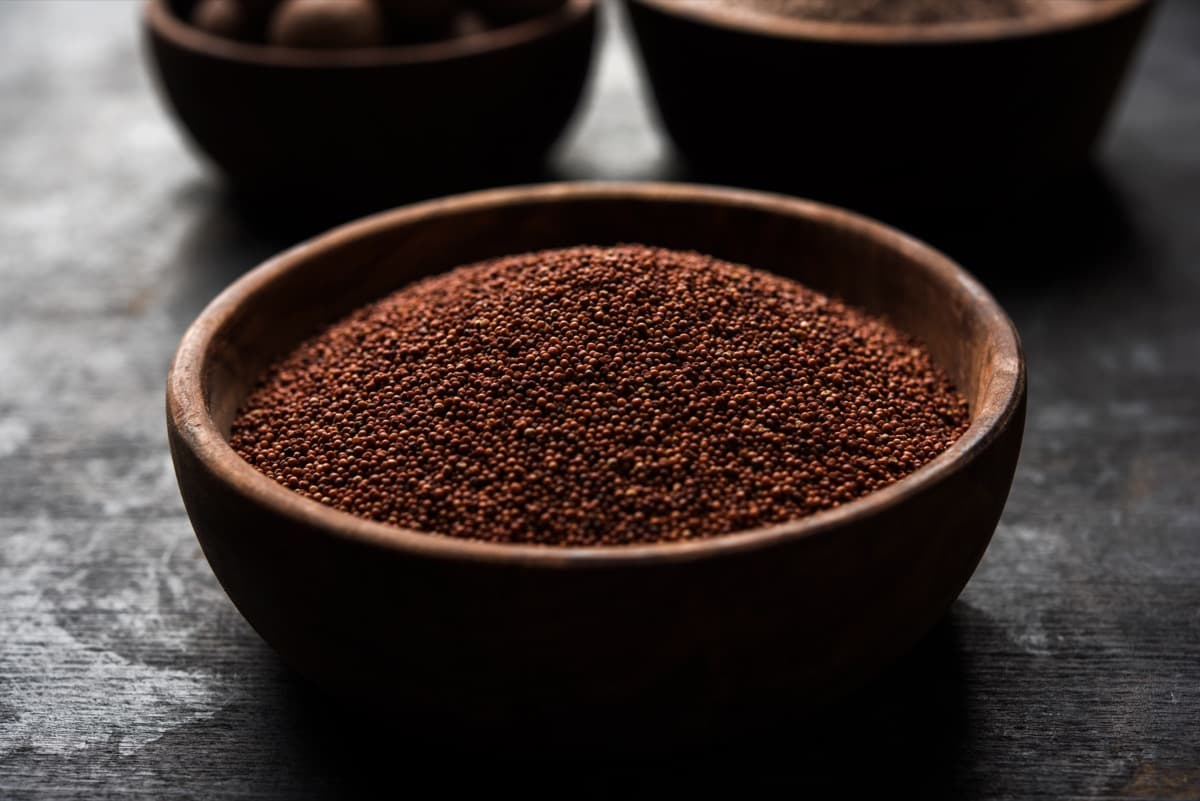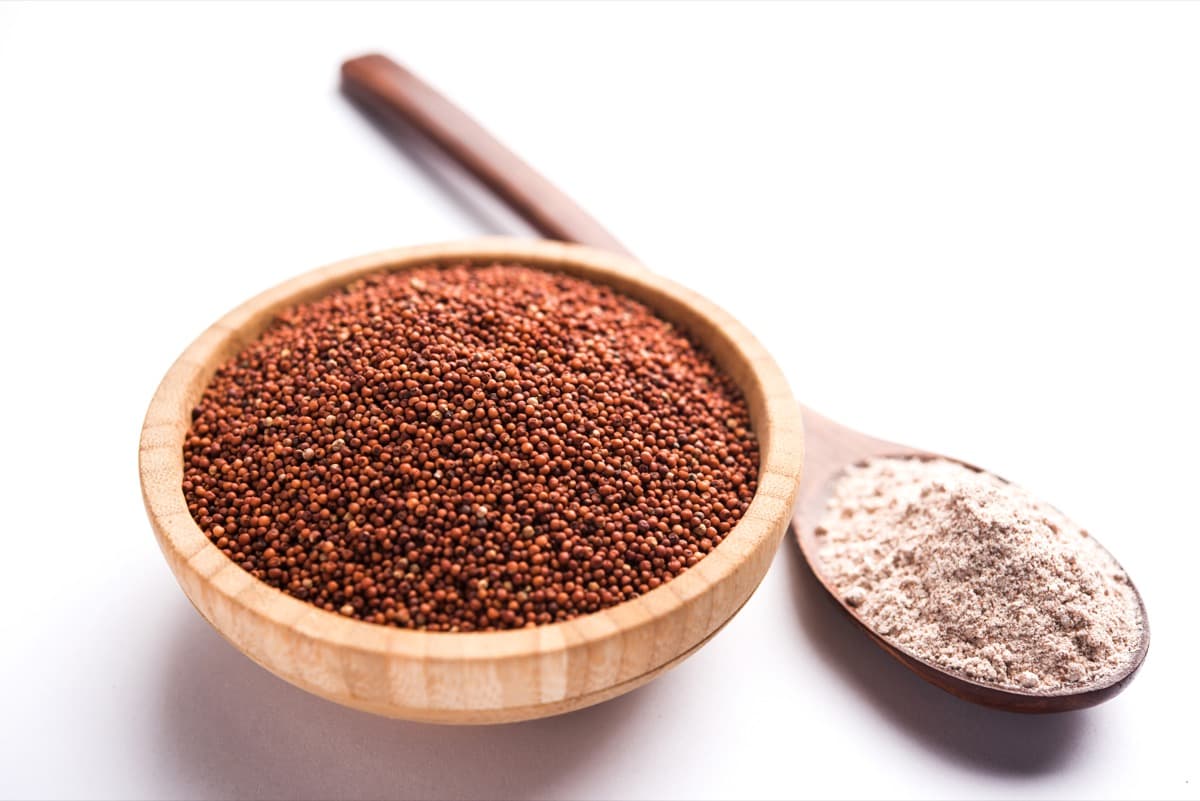Finger millet (Eleusine coracana) is a nutritious, climate-resilient crop with significant untapped economic potential. This study explores the profitability of cultivating finger millet on a 1-acre plot of land. By analyzing relevant economic data, including input costs, yield projections, market prices, and demand trends, we seek to assess the financial viability of finger millet cultivation.

Economics of 1-Acre Finger Millet Cultivation
Overview of Finger Millet
Finger millet cultivation involves growing and harvesting the seeds of a nutritious and resilient cereal crop belonging to the grass family, Poaceae. It thrives in cool, high-altitude regions of Asia. The mature plant ranges in height from 30-150 cm. Finger millet seeds come in white, light brown, or dark brown varieties and are consumed in different forms, such as unleavened bread, porridge, and alcoholic beverages.
Market and Demand for Finger Millet
The finger millet market is projected to experience a substantial growth of $4683.93 million between 2022 and 2027, with a compounded annual growth rate (CAGR) of 6.48%. This growth is driven by increasing global demand as more individuals prioritize health consciousness. Factors contributing to market growth include the easy maintenance of finger millet cultivation, the rising adoption of gluten-free diets, and the recognized health benefits of finger millet consumption.
Best High-Yielding Variety for Finger Millet Cultivation
There are numerous high-yielding finger millet varieties suitable for Cultivation. In India, notable improved varieties include CO-9, CO-13, CO (Ra)-14, TRY-1, Paiyur-1, Paiyur-2, VL Mandua-101, VL Mandua-124, VL Mandua-149, VL Mandua-204, VL Mandua-146, VL Mandua-314, VL Mandua-315, H-22, K-1, Hullubele, Karegidda, Gidda, Jasarilambi, Madayyanagiri-1, Madayyanagiri-2, Dodda, Jadesanga, and Jenumudda. These varieties offer higher yields and contribute to finger millet cultivation’s productivity and profitability.
Best Package and Practices for Finger Millet Cultivation/Farming
Climate: Finger millet thrives in tropical and subtropical climates and can be cultivated up to an altitude of 2100 m. It requires a minimum temperature of 8-10°C. The ideal mean temperature range during growth is 26-30°C, ensuring proper development and crop yield.
Soil: Finger millet is adaptable to a wide range of soils, from mean sea level to the foothills of the Himalayas. It can tolerate a certain degree of alkalinity. The best soils for finger millet cultivation are alluvial and loamy with good drainage are best for Cultivation.
Land preparation: Timely plowing is beneficial for moisture conservation. It is recommended to perform one deep plowing with a mold-board plow in April or May. Followed by that, plowing with a wooden plow twice is necessary. Before sowing, secondary tillage with a cultivator using a multiple tooth hoe helps prepare a smooth seedbed. Smoothening the land before sowing aids in better in-situ moisture conservation.
Soil and moisture conservation practices: To improve soil quality, summer plowing or plowing after the harvest of the previous crop is recommended. Plowing can be done across the slope. Small section bunds should be erected at 10-12 m intervals, depending on the slope, and depressions should be leveled. Opening a dead furrow at intervals of 3.3 to 4.0 m is also necessary.
Seed rate and treatment: The recommended seed rate is 8-10 kg/ha for line sowing and 4-5 kg/ha for transplanting. Treating the seeds with Thiram at a rate of 2.5 g/kg prevents diseases.
Sowing time and method: For the Kharif season, the suitable sowing time is June to July, while for the Rabi season, it is September to October. Line sowing is beneficial for inter-cultivation and weed control. The optimum plant population of 4-5 lakh/ha can be achieved by line sowing using a seed drill with a 22.5-30.0 cm spacing between rows and 7.5-10.0 cm between plants. Transplanting is done under irrigated conditions.
Nursery management: An area of 150 m² is required to raise seedlings for 1.0 ha. Well-decomposed farmyard manure (FYM), superphosphate, muriate of potash, and zinc sulfate, should be applied. Urea is top-dressed when the seedlings are 12-14 days old. Seedlings 21-25 days old are ideal for transplanting, with a spacing of 22.5-25 cm between rows and two seedlings per hill with 10 cm between hills.
Spacing and fertilizers: In direct sowing, spacing between rows should be 22.5 to 30 cm, plant-to-plant distance should be 7.5 cm, and depth should be 3-4 cm. Additional organic matter, such as 5-10 t/ha of FYM, is beneficial for soil improvement. Recommended fertilizer application is 60 kg N, 30 kg P2O5, and 30 kg K2O per ha under irrigation, and 40 kg N, 20 kg P2O5, and 20 kg K2O per ha under rainfed conditions.
In case you missed it: 1-Acre Foxtail Millet Farming Cost and Profit Analysis: Cultivation Economics and Production Project Report

Irrigation management: Finger millet generally grows in the Kharif season under rain-fed conditions. Depending on soil type, weather conditions, and variety duration, irrigation may be required during long dry spells. Light soils should be irrigated once every 6-8 days, while heavy soils should be irrigated once every 12-15 days. Critical growth stages like tillering and flowering may require irrigation with limited water availability.
Weed control: Early-stage weed control is essential for proper growth and development. Inter-cultivation and weeding should be done with a hand hoe 25 days after sowing (DAS). Line-sown crops may require 2-3 inter-cultivations and one hand weeding, while broadcast crops may need two effective hand weedings. Pre-emergence and post-emergence herbicide sprays can also be done as per recommendations.
Inter-cropping and crop rotation: Inter-cropping finger millet with crops like pigeon pea, field bean, soybean, black gram, moong bean, oats, or vegetables can be practiced in different regions. Crop rotation with legumes is recommended in northern states, while in southern states, horse gram, pigeon pea, field bean, or groundnut are suitable rotation crops.
Insect pests and their management: Finger millet is susceptible to armyworm, cutworm, stem borer, leaf aphids, grasshoppers, grey weevils, shoot flies, and ear caterpillars. Integrated pest management practices should be followed to manage these pests effectively.
Harvesting: The crop is harvested after 95-110 days for early varieties and 115-125 days for medium to late-duration varieties. Ear heads are harvested using sickles; in some rainfed areas, the whole plant with ear heads is cut, heaped, and later threshed.
Cost of Cultivation for 1-Acre Finger Millet Cultivation/Farming
The components typically included in the table of the cost of cultivation for finger millet cultivation are land preparation, seed cost, labor expenses, fertilizers and pesticides, irrigation, harvesting, and miscellaneous expenses.
| Components | Cost (INR) |
| Land preparation | 1,500 |
| Seed | 800 |
| Fertilizers | 4,000 |
| Irrigation | 1,200 |
| Labor | 3,000 |
| Pest and weed control | 800 |
| Harvesting and threshing | 800 |
| Miscellaneous expenses | 1,700 |
| Total cost of cultivation | 14,800 |
Total Returns and Net from 1Acre Finger Millet Cultivation/Farming
- The total cost of Cultivation: ₹14,800 Price per quintal: ₹3,800 Yield: 16 to 18 quintals
- To find the net return, we can calculate the total revenue generated from the yield and subtract the total cost of Cultivation.
- Minimum Yield (16 quintals): Revenue = Price per quintal × Yield Revenue = ₹3,800 × 16 = ₹60,800
- Maximum Yield (18 quintals): Revenue = Price per quintal × Yield Revenue = ₹3,800 × 18 = ₹68,400
- Net Return (Minimum Yield): Net Return = Revenue – Total Cost of Cultivation Net Return = ₹60,800 – ₹14,800 = ₹46,000
- Net Return (Maximum Yield): Net Return = Revenue – Total Cost of Cultivation Net Return = ₹68,400 – ₹14,800 = ₹53,600
- Therefore, the net return of finger millet cultivation would range from ₹46,000 to ₹53,600
Challenges and Risks in Finger Millet Cultivation/Farming
Finger millet cultivation faces challenges and risks such as unpredictable weather patterns, pests and diseases, limited access to quality seeds and inputs, market price fluctuations, labor-intensive farming practices, and inadequate infrastructure. These factors can impact crop productivity, profitability, and the overall success of finger millet farming.
Quick Facts About the Finger Millet Cultivation
Finger millet production involves cultivating and harvesting nutritious crops in Africa and Asia, particularly in India, Uganda, Kenya, and Ethiopia. It offers food security, high nutritional value, increased farmer income, and resilience to challenging environments. Production involves land preparation, seed sowing, pest management, irrigation, and timely harvesting. Challenges include seed accessibility, climate vulnerability, low demand, limited research, and lack of mechanization, prompting efforts to promote sustainable finger millet farming.
In case you missed it: Project Report of 1-Acre Proso Millet Cultivation: Cost, Profit Analysis, and Production Economics

Conclusion
Exploring the economics of 1-acre finger millet cultivation reveals its potential for profitability. With its nutritional value, adaptability to diverse conditions, and increasing market demand, investing in finger millet cultivation can be viable and profitable for farmers seeking sustainable and profitable agriculture.
- Feed Your Flock for Less: Top 10 Tips to Save on Chicken Feed
- Ultimate Guide to Ossabaw Island Hog: Breeding, Raising, Diet, and Care
- Hatching Answers: The Top 10 Reasons Your Chickens Aren’t Laying Eggs
- Eggs and Economics: Breaking Down the Cost of Raising Backyard Chickens
- Defend Your Greens: Proven Methods to Keep Iguanas Out of Your Garden
- Ultimate Guide to Cinnamon Queen Chicken: A Comprehensive Guide for Beginners
- Ultimate Guide to California Tan Chicken: Breeding, Raising, Diet, Egg-Production and Care
- Ultimate Guide to Marsh Daisy Chicken: Breeding, Raising, Diet, and Care
- 10 Types of Chicken Farming Businesses You Can Start for Profits